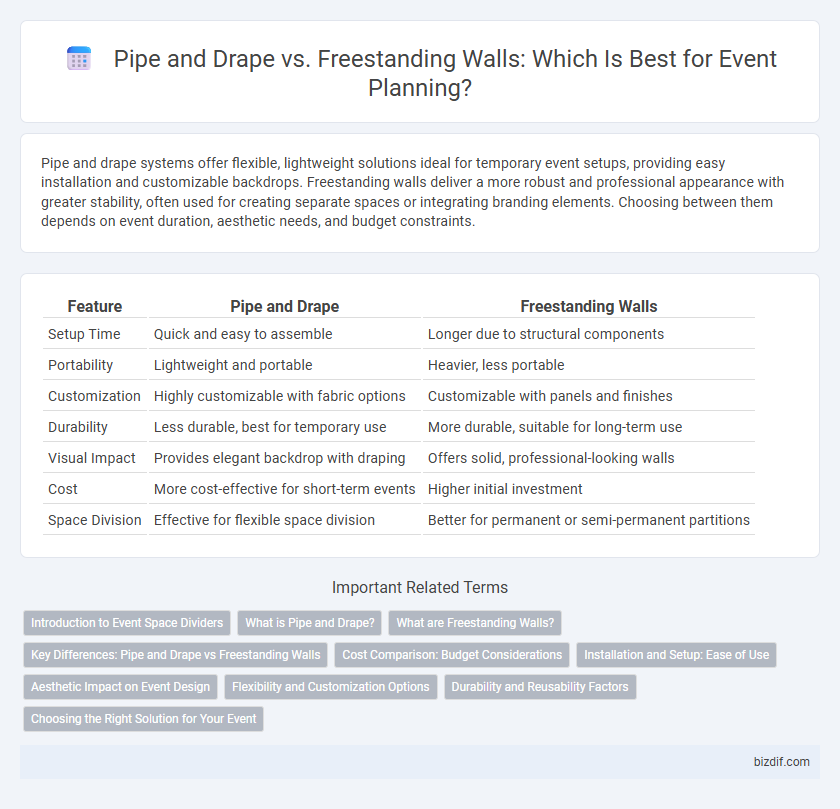Pipe and drape systems offer flexible, lightweight solutions ideal for temporary event setups, providing easy installation and customizable backdrops. Freestanding walls deliver a more robust and professional appearance with greater stability, often used for creating separate spaces or integrating branding elements. Choosing between them depends on event duration, aesthetic needs, and budget constraints.
Table of Comparison
| Feature | Pipe and Drape | Freestanding Walls |
|---|---|---|
| Setup Time | Quick and easy to assemble | Longer due to structural components |
| Portability | Lightweight and portable | Heavier, less portable |
| Customization | Highly customizable with fabric options | Customizable with panels and finishes |
| Durability | Less durable, best for temporary use | More durable, suitable for long-term use |
| Visual Impact | Provides elegant backdrop with draping | Offers solid, professional-looking walls |
| Cost | More cost-effective for short-term events | Higher initial investment |
| Space Division | Effective for flexible space division | Better for permanent or semi-permanent partitions |
Introduction to Event Space Dividers
Pipe and drape systems offer flexible, customizable event space dividers ideal for creating temporary partitions and enhancing aesthetics with fabric panels. Freestanding walls provide more robust, sound-insulating barriers suitable for long-term or high-privacy event space separations. Selecting between pipe and drape versus freestanding walls depends on factors such as installation ease, budget, acoustic requirements, and event duration.
What is Pipe and Drape?
Pipe and drape is a versatile event staging solution consisting of metal pipes and fabric panels that create temporary partitions or backdrops. Frequently used for trade shows, weddings, and conferences, it offers easy assembly and customizable height and width options to define spaces or conceal areas. Its lightweight, portable design makes pipe and drape a cost-effective alternative to freestanding walls for flexible event layouts.
What are Freestanding Walls?
Freestanding walls are modular, self-supporting structures used in event planning to create defined spaces without the need for existing walls or support. They offer flexibility in layout design, allowing for easy installation and reconfiguration to accommodate different event sizes and themes. Unlike pipe and drape systems, freestanding walls provide more solid, durable partitions that enhance privacy and sound control.
Key Differences: Pipe and Drape vs Freestanding Walls
Pipe and drape systems consist of lightweight fabric panels suspended on adjustable metal frames, ideal for temporary room division and event backdrops due to their flexibility and ease of setup. Freestanding walls offer sturdy, modular panels that create solid partitions, providing enhanced sound insulation and a more permanent appearance suitable for trade shows and corporate events. Key differences include portability--pipe and drape is highly portable--versus the structural stability and acoustic benefits offered by freestanding walls.
Cost Comparison: Budget Considerations
Pipe and drape systems generally offer a more cost-effective solution for event planning compared to freestanding walls due to lower rental and setup expenses. Freestanding walls provide greater structural stability and aesthetics but often require higher investment for materials, labor, and transportation. Budget-conscious planners usually prefer pipe and drape when temporary partitions suffice and financial constraints are tight.
Installation and Setup: Ease of Use
Pipe and drape systems offer quick installation with lightweight components that easily snap together, making setup efficient for various event venues. Freestanding walls require more time and effort due to their heavier materials and complex assembly, often needing additional tools or professional assistance. The ease of use with pipe and drape enhances flexibility, especially for temporary layouts and last-minute changes in event design.
Aesthetic Impact on Event Design
Pipe and drape systems offer a versatile and elegant solution for creating customizable backdrops that enhance the visual appeal of event spaces, allowing for seamless color coordination and branding opportunities. Freestanding walls provide a more solid and structured aesthetic, contributing to a polished and professional atmosphere while also enabling the use of artwork, logos, or digital displays for impactful presentations. Choosing between these options depends on the desired ambiance, spatial constraints, and the level of visual sophistication required for the event design.
Flexibility and Customization Options
Pipe and drape systems offer superior flexibility with easy setup, modular design, and customizable fabric options to fit various event layouts and themes. Freestanding walls provide more substantial structural customization, allowing for integrated lighting, signage, and themed decor but require more setup time and less adaptability during events. Choosing between pipe and drape or freestanding walls depends on the event's need for quick reconfiguration versus permanent, robust design elements.
Durability and Reusability Factors
Pipe and drape systems offer lightweight, flexible solutions ideal for temporary setups but often lack the durability of freestanding walls, which are constructed from sturdier materials like wood or metal. Freestanding walls provide superior reusability due to their robust design, allowing multiple event uses without significant wear or damage. Durability factors favor freestanding walls for long-term investments, while pipe and drape remain cost-effective for short-term or frequently changing event layouts.
Choosing the Right Solution for Your Event
Pipe and drape systems offer customizable, lightweight backdrops perfect for flexible event layouts, enabling quick setup and teardown. Freestanding walls provide sturdy, professional partitions ideal for noise control and branding opportunities, enhancing event aesthetics and functionality. Selecting the right solution depends on event size, budget constraints, spatial requirements, and the desired level of visual impact.
Pipe and drape vs Freestanding walls Infographic

 bizdif.com
bizdif.com